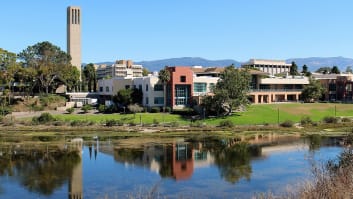The Best Environmental Science Programs and Professors

Earth Day is an annual celebration of our planet and the many natural gifts it has bestowed upon us. Every year, on April 22, we take pause to acknowledge the tremendous debt we owe our planet, as well as the hard work we have ahead of us in repaying this debt through conservation, restoration, and a more sustainable way of living. But for professionals in the field of environmental science, every day is Earth Day.
We take the time to acknowledge the contributions of environmental science professionals and to highlight the incredible opportunities that await students aspiring to become professionals in environmental sciences. We also cast a deserving spotlight on the best environmental science degree programs, the most influential environmental science professors, and the most influential books on environmentalism.
The Earth’s temperature is warming, the oceans are rising, and the ecological stasis of our planet is wildly out of balance. The mainstream scientific consensus says that global climate change is very real and that we are already experiencing the effects from decimated wildlife and food shortages to more frequent wildfires, more severe storms, and more catastrophic weather events. Not to get all doom-and-gloom on you, but as the next generation of college grads, you have your work cut out for you.
But if there is a silver lining behind the acid rain cloud, it’s that the fields of environmental science and conservation are brimming with career opportunities. There are countless ways to contribute to the battle against global climate change whether you plan to conduct field research on water quality, contribute to advances in alternative fuel, advise on environmental cleanup projects, audit industrial operations for regulatory compliance, and much more.
In fact, according to the Bureau of Labor Statistics (BLS), job opportunities for Environmental Scientists and Specialists are projected to grow at a rate of 8% by 2029, which is much faster than the average rate of job growth. Considering how much work there is to do, this isn’t surprising. And with a median annual wage of $71,360 in 2019, environmental science offers a strong starting salary and the chance to stand on the front lines in the enormously important battle against global climate change.
With each passing year, college graduates will come face to face with the mounting challenges of global climate change as they bleed into every aspect of our lives from labor and transportation to public health and safety. As a student of environmental sciences, you’ll be in a position to confront these challenges head on.
If you’re ready to get started on the path toward a degree in environmental sciences, check out the Most Influential Colleges and Universities for studying environmental science.
Otherwise, read on and find out which schools and professors are shaping the field today…
Featured Programs
Brief History of Earth Day
The first Earth Day took place on April 22, 1970. According to its originator, Senator Gaylord Nelson of Wisconsin, the purpose of the event was “to get a nationwide demonstration of concern for the environment so large that it would shake the political establishment out of its lethargy and, finally, force this issue permanently onto the national political agenda.”
College students played a particularly important role in this demonstration, with millions participating in rallies, educational programs, and marches on campuses throughout the U.S. Their efforts were recognized with a significant shift in public attitudes toward environmental concerns. Just months after the first Earth Day, in July of 1970, the Environmental Protection Agency was established to provide oversight and enforcement of environmental laws for the very first time. This was followed soon after by the passage of both the Clean Water and Endangered Species Acts.
Today, environmental regulation and global climate change remain pressing and hotly contested issues. And college students continue to lead the charge on these issues, seeking educational experiences and building toward careers that give them a chance not just to push for change, but to be a part of that change. For most students, this starts with the right environmental science degree program...
10 Best Colleges and Universities for Earning a Degree in Environmental Sciences
We ranked the influence of the environmental sciences sub-discipline at each of the world’s accredited colleges and universities using our InfluenceRankings, which measures the breadth of academic and popular influence of both the professors and students affiliated with each program. The result is a list of elite colleges offering highly interdisciplinary programs centered on the overlapping earth sciences, policy issues, and technical dimensions that shape this growing field.
For a closer look at how our InfluenceRankings work, check out our methodology.
1University of California, Berkeley
The Environmental Science, Policy, and Management Department’s Environmental Sciences (ES) major ranks atop the list of environmental sciences degree programs and offers an interdisciplinary program centering on the impact of human activities on natural systems. According to the program’s website, students in this degree program will learn to apply tools and techniques from a variety of disciplines such as biology, ecology, chemistry, toxicology, geology, hydrology, meteorology, geography, engineering, statistics, behavioral science, policy analysis, economics, and law. Learn more…
2Harvard University
The Environmental Science and Public Policy concentration at Harvard takes a multi-disciplinary approach to exploring current environmental problems. The program promotes both improved understanding of the underlying science and a deeper consideration of the economic, political, legal, historical, and ethical dimensions correlated to the health of our environment. Learn more…
3Stanford University
Undergraduate programs in environmental sciences at Stanford are housed in The School of Earth, Energy and Environmental Sciences (formerly the School of Earth Sciences), including closely connected programs such as Geological Sciences, Geophysics, Energy Resources Engineering, and Earth System Science. Students can also pursue an interdisciplinary Earth Systems bachelor’s degree. Learn more…
4Duke University
Environmental Sciences and Policy majors study the natural world and the human impacts on this world. Undergrads in this program will also explore the physical, biological, and social sciences essential to addressing the Earth’s most pressing environmental issues. The interdisciplinary program gives students a chance to pursue a three-course “sub-discipline” in topics such as climate change, sustainability, ecotoxicology, environmental justice, marine ecology, renewable energy, and environmental economics, among many others. Most students also get the chance to conduct independent research in their area of specialty. Learn more…
5Massachusetts Institute of Technology
Students who wish to study earth, atmospheric, and planetary sciences at MIT will benefit from world-class research facilities, extensive laboratory access, and experimentation with guidance from influential MIT faculty members. According to the MIT website, students will explore the genesis, structure, and dynamics of the Earth’s core and land surface, oceans and atmospheres, biosphere and solar system while integrating a study of biology, chemistry, mathematics, and physics. Learn more…
6State University of New York College of Environmental Science and Forestry
Students in this undergraduate degree program will develop a strong foundation in the sciences while delving into environmental science from an interdisciplinary perspective. Courses will address the geographical, physical, social, and living environments while also giving students a selection of concentrations in biology, chemistry, ecology, geography, engineering, forestry, environmental studies, and other areas of study. Learn more…
7California Institute of Technology
The Environmental Science and Engineering (ESE) merges the interdisciplinary nature of environmental sciences with the principles of engineering, providing students with the technical skills and knowledge to confront some of the most pressing challenges facing humanity. According to its website, the California Institute of Technology unites scientists and engineers from a variety of disciplines in order to focus their collective efforts on facing down big questions about our environment and the future of our planet. Learn more…
8University of California, Santa Barbara
Environmental Studies at UC Santa Barbara integrates the natural sciences, social sciences, and humanities into a program which explores the complex interactions between humans and the environment. Students are given the scholarly background and practical skills needed to confront the world’s greatest environmental challenges while exploring an extremely wide variety of environmental issues, including air/water pollution, animal rights, climate change, coastal processes, ecosystem restoration, endangered species, environmental ethics, environmental film and literature, environmental justice, environmental law, policy and politics, groundwater management, marine and terrestrial food systems, renewable energy, toxicology, forest management, traditional environmental knowledge, waste management, and urban and regional planning, just to name a few. Learn more…
9Yale University
Yale’s Environmental Studies (EVST) program combines the humanities, social sciences, and natural sciences, giving students the building blocks to create solutions for the biggest environmental problems that we face today. This interdisciplinary degree is available through both BA and BS programs of study. Students pursuing either course of study will complete a senior research project. Learn more…
10Syracuse University
Students in Syracuse’s Environment, Sustainability, and Policy major will study the nature of our changing planet and contribute solutions to advance sustainability while becoming more engaged as global citizens. This Integrated Learning Major (ILM) takes an interdisciplinary approach, combining the study of environmental science, sustainability, and policy with an emphasis on how these complex issues are shaped by both human and natural factors. Learn more…
Check out the full list of The Best Colleges and Universities for Studying Environmental Science.
Career Outlook for Students with Environmental Science Degree
Go to Degree Finder toolEnvironmental Science
Degree Level: Bachelor's
- Location: The U.S. (Private Schools)
- Avg. Cost of Degree*: $11,385
- Avg. Expenses*: $17,994
- Avg. Starting Salary*: $34,196
- Avg. Salary after 4 Years*: $48,271
- Avg. Cost Recoup Time**: 12 years
- Job Growth: 5.53%
- Number of Jobs: 562,800
- * denotes ‘annually’
- ** denotes ‘at 15% of annual salary’
Career Salaries
| Career | Job Growth | Avg. Salary |
|---|---|---|
| Forestry and Conservation Science Teachers, Postsecondary | 6.25% | $101,650 |
| Environmental Science Teachers, Postsecondary | 3.30% | $88,410 |
| Environmental Scientists and Specialists, Including Health | 7.21% | $78,980 |
| Compliance Officers | 5.42% | $75,670 |
| Conservation Scientists | 5.79% | $68,750 |
Top Industries
| Industry | Avg. Salary |
|---|---|
| Forestry and Conservation Science Teachers, Postsecondary | $101,650 |
| Environmental Science Teachers, Postsecondary | $88,410 |
| Environmental Scientists and Specialists, Including Health | $78,980 |
Most Influential Environmental Science Professors
What makes a great degree program? Great professors, of course! And in the field of environmental sciences, the work of the most influential professors transcends the walls of the laboratory and lecture hall. These professors make real and meaningful contributions to the real world with groundbreaking research, insightful analysis, and innovative solutions to the greatest environmental challenges facing humanity. Using our Influence Rankings to measure the breadth of their academic achievements and popular impact in their field, we identified the following as the Most Influential Professors in the Field of Environmental Sciences. If you’re planning to contribute to this important field, the following are some pretty great role models. And if you get into one of the top programs in the world, you could work directly with one of these influencers.
- Jeff Dozier is an American snow hydrologist, environmental scientist, researcher and academic. He is Distinguished Professor Emeritus and Founding Dean of the Bren School of Environmental Science & Management at the University of California, Santa Barbara. Learn more…
- Naomi Oreskes is a Professor of the History of Science, and an Affiliated Professor of Earth and Planetary Sciences at Harvard University. She earned a B.S. in mining geology from the Royal School of Mines of the Imperial College of London. She went on to earn a Ph.D in geological research and history of science from Stanford University. Her body of work has encompassed geology, scientific methods, climate change, plate tectonics, and the history and philosophy of science. Learn more…
- Keith John Beven is a British hydrologist and distinguished Emeritus Professor in Hydrology at Lancaster University. According to Lancaster University he is the most highly cited hydrologist. Learn more…
- Kenneth Caldeira is an atmospheric scientist who works at the Carnegie Institution for Science’s Department of Global Ecology. He researches ocean acidification, climate effects of trees, intentional climate modification, and interactions in the global carbon cycle/climate system. He also acted as an inventor for Intellectual Ventures, a Seattle-based invention and patent company headed up by Nathan Myhrvold. Learn more…
- Michael E. Mann is the director of the Earth System Science Center for Pennsylvania State University, a climatologist, and geophysicist. He has earned an A.B. in applied mathematics and an A.B. in physics from the University of California at Berkeley, before earning an M.S. and M.Phil in physics, an M.Phil in geology, and a Ph.D in geology & geophysics from Yale University. His work has resulted in new techniques for recording and evaluating past climate data and how to distinguish between useful climate data and statistical noise. Learn more…
- Asmeret Asefaw Berhe is a soil biogeochemist and political ecologist. She is currently Professor of Soil Biogeochemistry and the Ted and Jan Falasco Chair in Earth Sciences and Geology in the Department of Life and Environmental Sciences; University of California, Merced. Her research group works to understand how soil helps regulate the earth’s climate. Learn more…
- Johan Rockström is a Swedish professor who served as executive director of the Stockholm Resilience Centre at Stockholm University. He is a strategist on how resilience can be built into land regions which are short of water, and has published over 100 papers in fields ranging from practical land and water use to global sustainability. Johan Rockström was Executive Director of the Stockholm Environment Institute from 2004–2012. Learn more…
- Ahmed Abukhater is an architect, environmental scientist, and an urban and regional planner by trade. He is an author, powerlifter, and the first athlete to represent Palestine at the World Association of Bench Pressers and Dead lifters (WABDL) World Powerlifting Championships in Las Vegas, Nevada in 2006. In November, 2007, Abukhater represented Palestine again in the WABDL World Championship, in Anaheim, California, where he won his division and set a new Palestinian world record.[6] He set a new record for the state of Illinois in 2004, and holds many national and international records in powerlifting. Learn more…
- Wilma Subra is an American environmental scientist. She is President of the Subra Company, an environmental consulting firm. Learn more…
- James Ephraim Lovelock, is an English independent scientist, environmentalist, and futurist. He is best known for proposing the Gaia hypothesis, which postulates that the Earth functions as a self-regulating system. Learn more…
Though the field of environmental sciences is led by deep thinkers and noteworthy academics such as the luminaries identified here above, their efforts are often opposed by industry leaders, lobby groups, and business-friendly public office holders. This is why global climate change remains a fiercely debated issue in American public and political life. It also explains why climate change actually ranks near the top of our list of the 25 Most Controversial Topics Today.
To learn more about the push and pull around climate change, check out our look at this controversial topic.
Or, you can research climate change with a look at the most important books written on the subject over the last 60 years…
10 Most Influential Books on Environmentalism
In the years prior to the first Earth Day in 1970, we had limited awareness of the impact that human activity had on the environment. However, heightened nuclear anxieties, armed conflicts over fossil fuels, and tangible evidence of pollution in our air, soil, and water gave way to a growing sense of urgency. This sense of urgency was captured first, and perhaps best, in Rachel Carson’s landmark 1962 text, Silent Spring.
It is unsurprising that Carson’s text, often identified as a major catalyst for a broader environmental movement, ranked first for the term “environmentalism” using our backstage ranking engine—Ranking Analytics. Using the time parameters of 1960-2020, we vetted this list for relevance—removing religious scriptures and popular fiction which may have been included for their incidental usage of related terminology. The result is a ranking of the 10 most influential books related to environmentalism, including those which take a scientific, economic, policy-related, or philosophical perspective on the issues at hand.
| Book Title |
|---|
Silent Spring, By: Rachel Carson  |
The Population Bomb, By: Paul R. Ehrlich  |
A Sand County Almanac, By: Aldo Leopold  |
Whole Earth Discipline, By: Stewart Brand  |
The Shock Doctrine, By: Naomi Klein  |
Walden, By: Henry David Thoreau  |
Diet for a New America, By: John Robbins |
Merchants of Doubt, By: Naomi Oreskes  |
The Monkey Wrench Gang, By: Edward Abbey  |
The Green Bible, By: Harper Bibles |
For a more purely scientific exploration of the environment and related issues, check out our list of the 25 Most Influential Books in Earth Sciences/Geosciences 2010-2020.
***Would you like to be part of the fight against environmental abuses and global climate change?
Check out the full list of the Most Influential Colleges and Universities for studying environmental science and get started today!










